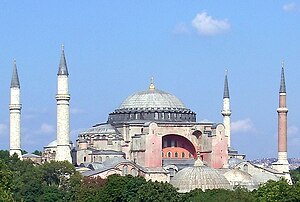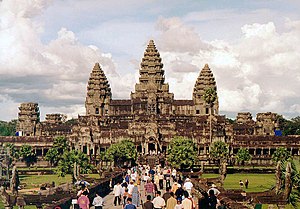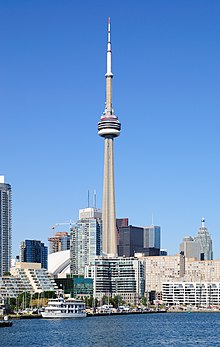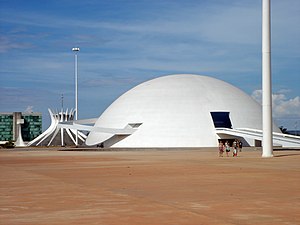Architecture is concerned with the design and construction of buildings. The architecture of a place is often a tourist attraction in its own right. Many buildings are quite beautiful to look at and the view from a tall building or from a cleverly-positioned window can be a beauty to behold. Architecture overlaps considerably with other fields including urban planning, civil engineering, decorative arts, interior design and landscape design.

Some of the finest examples of architecture are almost fractally interesting — there is something worth a look whatever scale you choose. From a meter away, the impressive thing about the Taj Mahal is the fine stone inlay work on many surfaces. Moving back, one sees the building as a whole and the extensive gardens; to get the full context one needs to look at the history of the Mughal Empire and the traditions of Islamic art. Someone looking at a Frank Lloyd Wright house might consider anything from what it would be like to cook in that kitchen to how the place fits into its neighbourhood.
Many examples of fine architecture are on the UNESCO World Heritage List.
Understand
Historic buildings often tell their own story and provide a place with a heritage that asks the visitor to find out more.
Ancient buildings

- Stonehenge
- Pyramids in many places, most notably the great Egyptian pyramids at Giza
- The Egyptian temples of Karnak, Luxor (in the eponymous city) and Abu Simbel
- The Parthenon in Athens
- The Great Wall of China
- Remnants of the Roman Empire throughout Europe, Western Asia and North Africa. Architectural feats of the Roman Empire remain impressive for their longevity if nothing else. Many feats of civil engineering were only reached again in the industrial revolution surpassed in the 19th century or even later. Some of the most notable sites are:
- The Pantheon in Rome - best preserved Roman temple anywhere, oldest important building in the world with its original roof intact - a dome with a revolutionary design for its time (which remains the record holder for the biggest unreinforced concrete dome in the world), probably designed by emperor Hadrian; widely claimed as THE ultimate architectural masterpiece of all time.
- The Pont Du Gard aqueduct near Nîmes
- Theaters at Orange and Taormina
- Amphitheaters at Verona, Pula and El Jem
Religious buildings
- See also: Religion and spirituality
Cathedrals, temples and other places of worship have, until recently, been among the most notable and longest lasting forms of architecture.
Cathedrals


- See also Christianity, Gothic architecture
- Notre Dame in Paris
- Cathedral of Chartres
- Hagia Sophia in Istanbul was built as an Eastern Orthodox church, but was later turned into a Roman Catholic church and still later a mosque. Today, it is a museum.
Mosques
- See also Islam
- Dome of the Rock/Masjid Al Sakhrah in Jerusalem
- The many mosques built in the Indian subcontinent under the Mughal Empire
Stupas
- Bodhgaya, Bihar State, India - the site where Shakyamuni Buddha gained enlightenment.
- The Great Stupa of Bodhnath, Kathmandu - the heart of Vajrayana Buddhism in Nepal.
Temples
- Angkor Wat, originally a temple of the Hindu god Vishnu
- The many pagan temples of Ancient Greece and the Roman Empire
Civic buildings

There are a large number of buildings for civic or governmental purposes. These include:
- Seats of government
- Transportation centres such as railway stations and airports; in some cases even something as seemingly commonplace as an urban rail station has been designed as an architectural statement.
Memorials
Around the world, commemorative structures are amongst the most notable tourist attractions. For example:
- Tombs
- The burial mounds of some prehistoric groups; see archaeology
- Egyptian pyramids
- Chinese tombs, including the first Qin Emperor's tomb with the Terracotta Warriors
- The Taj Mahal in Agra, tomb of an Emperor's wife
- Many capital cities around the world have a War Memorial or a Tomb of the Unknown Soldier
Record-holding structures
Building the tallest building in the world is every architect's dream (or perhaps nightmare) project, as it will eventually be topped by an even taller structure. See the Chicago skyline guide for information on the many tall buildings in Chicago, the birthplace of the skyscraper.
Tallest buildings

Note that the number eight is considered lucky in much of East Asia and hence this number is often deliberately chosen for things like number of floors.
- Burj Khalifa, Dubai, UAE (Built 2010) 160 storeys 828 m
- Taipei 101, Taipei, Taiwan (Built 2004) 101 storeys 509 m
- Petronas Tower 1, Kuala Lumpur, Malaysia (Built 1998) 88 storeys 452 m
- Petronas Tower 2, Kuala Lumpur, Malaysia (Built 1998) 88 storeys 452 m
- Sears Tower, Chicago, USA (Built 1974) 110 storeys 442 m
- Jin Mao Building, Shanghai (Built 1999) 88 storeys 421 m
- Two International Finance Centre, Hong Kong (Built 2003) 88 storeys 415 m
- CITIC Plaza, Guangzhou, China (Built 1996) 80 storeys 391 m
- Shun Hing Square, Shenzhen, China (Built 1996) 69 storeys 384 m
- Empire State Building, New York,USA (Built 1931) 102 storeys 381m
- Central Plaza, Hong Kong (Built 1992) 78 storeys 374 m
Tallest towers
- CN Tower, Toronto, Canada (Built 1975) 553 m
- Ostankino Tower, Moscow, Russia (Built 1967) 537 m
- Oriental Pearl Tower, Shanghai, China (Built 1995) 468 m
- Sky Tower, Auckland, New Zealand (Built 1997) 328 m - Tallest in southern hemisphere.
- Sydney Tower, at Centrepoint, Sydney, Australia (Built 1981) 305 m
- Eiffel Tower, Paris, France (Built 1889) 300 m when built, 324 m with TV antenna.
In the USA (and from 1974 to 1991 in Poland) there are some guyed radio masts, which were taller. The tallest construction built so far, was the Warsaw radio mast near Gabin.
Other records

Of course, height is not the only way in which a building might be remarkable. Other records include:
- The Marina area of Dubai had seven of the world's ten tallest residential buildings as of 2010.
- Edificio Copan in São Paulo is "only" 38 stories, but it has 1160 apartments and is considered the world's largest residential building by floor area
- Largest buildings by roof area: the two Hajj terminals at Jeddah airport, which each handle dozens of large aircraft carrying Muslim pilgrims.
- Longest structure on Earth: the Great Wall of China is several thousand km. It is arguably not really all one structure, different parts having been built by different dynasties centuries apart, but even those parts are enormous.
- Depending on how you define "structure" the great Dingo-fence that crosses Australia is even larger than the great wall of China
Several industrial buildings are huge do to the nature of the work done there. Examples include:
- The former Cargolifter hall in Brandenburg, which has the biggest single span roof in the world and was designed to hold a Zeppelin that never was and now houses a tropical themed water amusement park
- The Meyer Werft in Papenburg, Lower Saxony where cruise ships are built (tour possible). It is by far the biggest dry dock and one of the biggest buildings in the world.
- The Boeing factory in Everett (Washington), Washington state - the biggest man made structure by interior volume
Unusual buildings

Some buildings are unique....
- The Leaning Tower of Pisa is often considered unusual, though a pagoda in Suzhou has been called the "leaning tower of China" and there are other less famous leaning towers in various countries, including several elsewhere in Italy.
- Prora on the Baltic Sea has a hotel for 20,000 workers on holiday, created by the Nazi regime in Germany, never used for its intended purpose, never completed, later used as barracks by the GDR, and now housing a museum as well as accommodation while being mostly empty
- The Hakka Tulou of southern China are mostly-earth easily-defended buildings, home to entire clans of a few hundred people
- The diaolou (castles) of Kaiping are fanciful houses built by overseas Chinese, mostly in the early 20th century
Architectural styles
Some styles like Art Deco attract tourists to visit. The town of Napier, New Zealand, is largely built in the Art Deco style after the town was rebuilt in the 1930s following an earthquake. The local historical society has capitalised on this and runs frequent walking tours around the buildings.

- Classical architecture
- Romanesque architecture
- Islamic architecture
- Gothic architecture
- Eastern Orthodox church architecture
- Renaissance architecture
- Mughal architecture
- Baroque architecture
- Art Nouveau architecture
- Art Deco architecture
- Modern architecture
- Socialist realist architecture
- Nazi architecture
With the rise of the automobile, novelty architecture has been used as a means of roadside promotion. Examples would include restaurants shaped like oversized oranges or motels in which each room is a railway caboose or a concrete wigwam.
Well-known architects
Le Corbusier

The Swiss-French architect Charles-Édouard Jeanneret-Gris (1887-1965) was better known under his artist name, Le Corbusier. Regarded as one of the fathers of modern architecture and urban planning, his buildings can today be seen in Europe, the Americas and India. His architecture and his views regarding how people should use his buildings remain controversial to this day and if you see his creations, you might get an idea why.
Some works of this architect are the planned city of Chandigarh, the Villa Savoye in Poissy outside Paris where he expressed his "five points of new architecture", the Immeuble Clarté in Geneva, the Centrosoyuz Building in Moscow, the Carpenter Center for the Visual Arts in Cambridge (Massachusetts), four "Unité d'habitation" apartment buildings around Europe which later served as inspiration for Brutalist architecture and many "villas" in France and Switzerland including his own cabin on the French Riviera where he spent the last years of his life.
I.M. Pei

I.M. Pei (1917-) spent his early years in China, but came to the USA for university and has lived there most of his life. He has designed buildings in many places. He is very much a modern architect, heavily influenced by the European Bahaus school. Pei designed a number of important public buildings including Dallas city hall, the National Center for Atmospheric Research in Boulder, and the Kennedy Library and the John Hancock Tower in Boston. He has also done commercial buildings, notably the Bank of China tower in Hong Kong.
Museums were a specialty; perhaps his best-known work is the controversial glass pyramid outside the Louvre in Paris. Other projects included the East Building of the National Gallery of Art in Washington, DC, an extension of the German Historical Museum in Berlin. the Rock and Roll Hall of Fame in Cleveland, the Museum of Islamic Art in Doha and the Miho Museum near Kyoto. He came out of retirement in his 80s to design a museum for the Chinese city of Suzhou where his family were from.
Frank Gehry

The Canadian-American architect Frank Gehry (1929-) is known for his Deconstructivist creations which include Guggenheim Museum in Bilbao, Dancing House in Prague, the Art Gallery of Ontario in Toronto, MIT Ray and Maria Stata Center in Cambridge (Massachusetts), Walt Disney Concert Hall in downtown Los Angeles, the Vontz Center for Molecular Studies on the University of Cincinnati campus, New World Center in Miami Beach, Weisman Art Museum in Minneapolis, and the California Science Center in Los Angeles.
Oscar Niemeyer

Brazilian architect Oscar Ribeiro de Almeida Niemeyer Soares Filho (1907 – 2012) is considered one of the key figures in the development of modern architecture. Strongly influenced by Le Corbusier, Niemeyer is best known for his design of civic buildings for Brasília, Brazil's planned capital city from 1960 on, and of Belo Horizonte's Pampulha Architectural Complex. His collaboration with other architects on the United Nations Headquarters in New York City is widely praised as well. His exploration of the aesthetic possibilities of reinforced concrete was highly influential in the late 20th and early 21st centuries. Both lauded and criticized for being a "sculptor of monuments", Niemeyer is held as a great artist, and one of the greatest architects of his generation, by his supporters, and accused of a highly criticizable architecture, functionally and budget-wise, by his detractors.
Santiago Calatrava

Valencian architect, structural engineer, sculptor and painter Santiago Calatrava Valls (born 28 July 1951), early in his career, was largely dedicated to designing bridges and railway stations with a "neofuturistic" approach. He is most famous for the Olympic Communications Tower on the Montjuïc hill, built for the 1992 Olympiad, and several avant-garde bridges: the Chords Bridge in Jerusalem, the Alamillo Bridge in Seville, the Ponte della Costituzione (more popularly the Calatrava bridge) over Venice's Grand Canal, the Kronprinzenbrücke over the Spree river in Berlin, the Campo Volantin Footbridge over Nervion river in Bilbao and several others.
Mimar Sinan

"Sinan the Architect" (c. 1489/1490 – July 17, 1588), the famous Ottoman master, was born the son of a stonemason, received a technical education and became a military engineer. He rose rapidly through the ranks, became first an officer and after that a Janissary commander. In his military career, he refined his architectural and engineering skills, becoming expert at constructing fortifications of all kinds, as well as military infrastructure projects, such as roads, bridges and aqueducts. At about the age of fifty, he was appointed as chief royal architect, applying the technical skills he had acquired in the army to the "creation of fine religious buildings" and civic structures of all kinds, remaining in this post for almost fifty years. Sinan is said to have constructed or supervised 476 buildings (196 of which still survive), according to the official list of his works, the most famous and masterly built of which are, first and foremost the Selimye mosque in Edirne, followed by the Imperial mosques and bathhouses in Istanbul, Damascus and Sofia. He lies in a tomb of his own design, in the cemetery just outside the walls of the Süleymaniye Mosque, across a street named Mimar Sinan Caddesi, in his honour.
